Discovery 2019 — Student Reflections
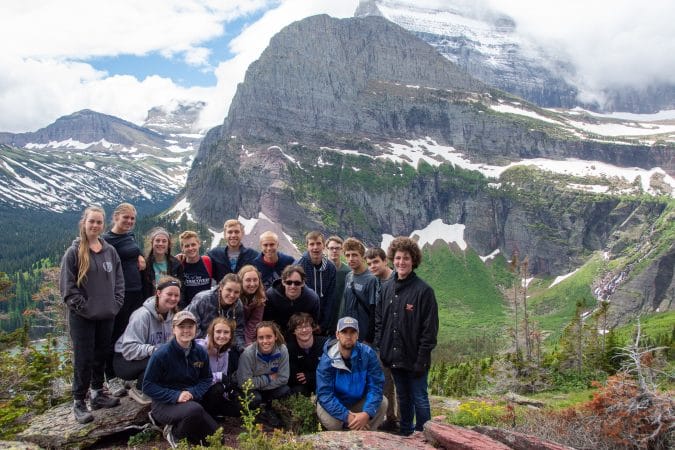
Discovery 2019 took 20 students across the country and back again from June 4 to 29. They learned about land and water issues, immigration, Native communities, resource management, energy consumption and more. They read articles to prepare for each stop along the way so they could bring questions, listen carefully, and then reflect on what they had heard. They tented and ate simple meals they prepared together. Here are some of their reflections. Read more about Discovery. Photos by Aaron Moyer.
Banana, by Emma Schwertfuehrer
A month ago, when I ate a banana for breakfast, I didn’t think a whole lot about it. This morning, however, as I cut up a banana for my oatmeal, I wondered who picked it. I wondered if, somewhere, thousands of miles away, the person who picked my banana wanted to be doing a job that I, the consumer, would never thank him for. I wondered how much of the 25 cents that my banana cost actually went into his pocket. I wondered who was suffering so I could eat fruit this cheap.
A little over two weeks ago, I learned from some representatives from the Berry Center in Kentucky that when my food comes cheap, someone out there is suffering the consequences. I learned that while my wallet mourns the loss of a quarter for my banana or a dollar for a gallon of milk, a banana picker tries to scrounge together the half-cent scraps left behind by the deliverers to feed his family, and dairy farmers hope that the three cents they earned from that gallon of milk will be enough to keep their farm from joining the crowded ranks of dairy farms that close weekly.
I like to think of myself as a money saver, a trait I learned from my parents. I stick to the paperback books, and given the option between two prices at the store, my default is the less expensive one. I don’t need the highest quality; I just need enough. Isn’t that the right thing? But after all this time of believing the inexpensive way is the right way, I’ve once again been opened up to my own ignorance. It looks like (surprise) I don’t have everything figured out. That’s why we need to continue to learn about people around us and how what we do affects our neighbors.
Maybe after I get home, I’ll be a bit less stingy about my money. Maybe not right away. But maybe if I keep wondering about who picked my banana, I won’t forget those who suffer consequences for my convenience. If we all think about who picked our bananas, we might be able to shoulder some of those consequences together instead of shoving them off on someone we can’t see.
Next time you eat a banana, then, ask yourself who picked it.
Our relationship with food, by Meghan Eggert
The first issue that we studied on this trip was food. We thought about our relationship with land, the people who grow our food, and where our food comes from. Although the way we as middle class individuals treat the earth may not directly affect us in the current moment, it will in the future and currently negatively affects others. Middle and high class individuals are taking more from the earth than the earth can produce, which is the definition of the tragedy of the commons. The tragedy of the commons affects everybody that uses the land, which is everybody in existence. If we do not change the way we interact with land soon, natural resources and food will become harder and harder to come by, which will in turn cause lots of death and an overall decrease in quality of life.
Our first stop on Discovery was Kentucky, where we met with members and friends of the Berry center. Our discussion with these people was very eye opening. It was appalling to hear that for every $1.25 that we spend in the grocery store, the farmers only receive about 13 cents. Our discussion with these people causes us all to reconsider our desires to always buy the cheapest goods at the grocery store. Hopefully, those of you who are able to buy more directly from farmers will do this instead of always choosing the convenient option of buying at Target, Walmart etc. We were then able to visit Monsanto, a big agriculture company that tends to put money before quality or customers. This experience brought questions to our minds like: How much money is too much? Should wealth be more evenly distributed among the population? And do the pros of big food production companies outweigh the cons? Although we do not know the complete answers to these questions, they are important for us to contemplate and discuss with one another. Since our population is so large, we would not be able to survive without the large food producing corporations, but how can we as a society improve their practices. How can we make these corporations more beneficial for the public/ consumer, and safer?
While we were in Kansas City, Kansas, we spent time at Rainbow Mennonite Church’s Urban Gardening Project. The Urban Gardening Project hosts gardens across the city, which are open to the neighborhood. At Rainbow Mennonite, the garden also feeds the children who attend their summer camp. While we were at this garden, we volunteered and helped the garden organizers weed and plant. Although some of us have grown up on farms, others like myself have not, so this experience was able to give us a bit more appreciation for farmers, and those who grow our food.
The Land Institute in Salina, Kansas, was our next stop where we learned more about sustainable agriculture. Wes Jackson, the founder of the Land Institute, took time to talk to us about the importance of sustainable agriculture as well as tell us a bit about how society is depleting the earth’s natural resources.
The last place we visited to think about the issue of food was Quinter, Kansas. Here we met with the Wolf family who taught and showed us why good soil structure matters and is vital for crops. Mr. Wolf also talked about the difference between a tilled and no-tilled field and how tilling your fields can negatively affect both the quality and quantity of your crop.
Although all people do not agree on the way in which we should treat the earth, it is about time that we all work together to change the way we treat the earth for the better. We can all agree that natural resources and food are vital for our survival, so why don’t we do something about their depletion? If we continue to live selfishly, all of the earth’s resources and food will be depleted and we will not survive.
On immigration in San Diego, by Emma Myers
I Have Hope
“I have hope,” says the girl who grew up in the golden cage.
“I have hope,” says the girl who might not be able to hug her family again.
“I have hope,” says the girl who’s right to a better life is in the hands of someone who doesn’t think she deserves it.
“I have hope,” says the girl who was always scared that a classmate would report her to ice because she was doing better than them.
“I have hope,” says the girl who sees the next generation of fighters who are kinder than ones past.
“I have hope.”
I Cannot Ever
It is easy to dehumanize someone when you cannot see their face. The bars of a fence distort and confuse, and words are blocked by a language barrier. I cannot ever know them.
It is easy to dehumanize someone when you call their existence “illegal”. A small child locked in a cage is acceptable because they didn’t come to our country legally. I cannot ever live their life.
It is easy to dehumanize someone when you cannot understand the life they live. A scorching path through the desert is a better path than a home of violence and fear. I cannot ever walk their path.
It is easy to dehumanize someone when you think their life is worth less than yours. A person’s life to a better life should not depend on the color of their skin or the language of their mouth. I cannot ever comprehend their struggle.
The Colorado River, by Maya Ferrell
Rocky Mountain meltwater
Flows down.
The Sudden Rush
Creates enough
To go around.
But it’s drying up.
The lake Mead water level drops.
New ways to share must be found.
Water doesn’t flow from a faucet everywhere.
We must be mindful.
The Land Institute, by Zach Bauman
While the acreage may be grand
The Institute has few workers
As a community they toil
Cross pollinate plants
Practice water management
Enrich soil
Sustainable crops for our future
Different Ways of Looking at Food, Samantha Forbes
Berry Center
Gives the right prices
For the farmer’s local cows
Fights for the farmer.
Monsanto (Bayer)
Big corporation
Creating and changing seeds
Wants to feed the world.
Urban Gardening
Created a few plots
To teach city kids to plant
A garden for them.
Land Institute
Very long visions
Trying to create the future
Sustainably.
Farms in Kansas
Rows and rows of wheat
Growing in a nearby field
Perfect if grown right.
All of these places
Have food and farmers in mind
Long term and short term.
The Farm, by Jacob Hess
From the food week, we learned that there is more to the issue of methane from cows, and land being taken for farming. The sentiment in the farming community is adapt, or die. One of the ways that they need to adapt, is to expand way too much to a point where if they have a bad year, they could lose it all in one foul swoop. Part of that, is as they are forced to expand, they get paid very little. If you have seen a gallon of milk for instance, that is a dollar. The farmer will see a very small amount of the money that gallon sold for, maybe a cent or so. Companies who are distributing these products, are not trying to help the issue. They are helping it by taking most of what a farmer makes. This is where Co-Ops and farmers’ markets come into play. They are a way for farmers to get their products to you in a way that benefits themselves, and you, since you know that it is fresh and organic. Other things that help farmers is to buy in season, and to not buy the cheapest thing at the supermarket.
After we talked with the Berry Center people I felt like I am hypocritical. I notice that the American people get mad for good things, but they don’t look into them, they don’t do their own research. They just take what’s on the news as truth, and don’t find out anything else. I always thought that farmers could control emissions of methane by having less cows, but now I know that farmers can’t control it. They are forced to expand by companies, and the expectations of how to farm. I want people to find out more about an issue, because more likely than not, there is another hidden force/issue behind the one you are getting mad at.
Colorado River, by Ava Galgano
While we were in the Colorado River area we studied water and the conservation of it. We began at the Land Institute where we talked to Wes Jackson. He talked to us about the fact that community falls apart when you are the only one you care about. He said, “We are so focused on how I will make it, instead of being focused on how can this problem be solved for good, so that every person can make it?” This made me think a lot about the impact we have on our water usage. In Harrisonburg, we don’t have fear of water not coming out of our tap, but here they do, and we impact that more than I had originally thought.
A few days later we were in Arches National Park, aka the desert. Although we saw minimal green and were in hot temperatures the whole time, the whole desert thing hadn’t really sunk in yet. The next day we were hiking through the arches and were told we did not need to fill up our water bottles, because there was a fountain at the trailhead. Our group of 30ish people waited in line for about 30 minutes for everyone’s water bottle to be filled. The water from the faucet was barely trickling out. I have no idea if this has anything to do with being in the desert, or just some not great pipes, but water scarcity had hit me. That evening we talked with Tamsin, who would be our river guide for the next two days. We talked about how the Colorado River provides water to 7 states and Mexico, but does not always reach Mexico.
We then went to the Yuma Desalination Plant in Arizona. We talked with Nick Heatwole who told us about how 90% of the vegetable produce we eat in the winter months is produced within 30 miles of the plant. This plant specifically works with the desalination, but also buys and sells Arizona water. We took a tour of the plant with an engineer who talked about the fact that the Colorado River supports all cities, golf courses, hotels, and residential areas. In the desert, that’s a lot of water. This plant has become a neutral referee in the fight for water. Previously people had been pumping out groundwater and irrigating their fields. This caused most of the water to evaporate, leaving all the fields full of salt. As you can imagine, this impacts farmer’s yields. In 1944, Mexico and the United States made an agreement over the amount of water that Mexico has to receive from the Colorado River. This agreement did not initially cover the quality of water, and the high salt content was not desirable for Mexico. This led to the creation of the MODE plant, which is a reverse osmosis plant that helps to purify the water sent to Mexico. This process treats the water with chlorine to kill bacteria, separates the sediment, pushes it through intake pumps, and adds lime and ferric phosphate to remove sludge and other random solids/contaminants. These reactions form precipitates that can be filtered through easily. Sulfuric acid and ammonia are then added to prevent scale buildup.
The most surprising part, is all this is not currently in use. So you may ask why all the trouble for something that is not currently needed? The plant is currently dormant and is trying to satisfy safety issues and improvements that need to happen before it can began running. An example of this is that the plant would use 250 tons of Lyme per day.Requiring that their current towers be refilled with 10 truckloads per day, which is not ideal or cost efficient. Even though the plant still has things to figure out, it has given me incredible hope. Before the desalination plant I wasn’t very optimistic about our water usage. Although something will definitely need to change dramatically, things are being done in preparation for the day when the water is no longer pristine.
The Water Song, Chad Vrolijk
Wa-ter wa-ter
Oh wa-ter
Is a nec-essity.
Farmers know to
pre-serve it
with no- till and
flood irriga-tion.
Which allows less run-off,
And the next with aque-ducts
To put wa-ter
Back in the ri-ver
After it waters the fi^eld.
Oh wa-ter
People are so gree-dy
And hate to share their wa-ter,
So we had to build a plant.
To send cleaner wa-ter
To Mex-ico.
Oh wa-ter
When the only source of wa-ter
Is from the Colora^do Ri-ver.
Which gets the wa-ter
From th^e snow-melt
From the Rocky Moun-tains.
Yeah wa-ter
You keep us liv-ing
And alive in the de^sert.
Wa-a-ter rocks.
Glacier Reflection, Emma Myers
The Story of Glacier
My calves burned, my skin simultaneously burning and freezing.
Rocks shifted underfoot with each careful step,
A reflection of the earth towering around me.
Sharp reds, soft blues. Stormy grays and dusted browns.
The last snow of the season runs its path down the mountain side,
Cutting through the rock and undergrowth, taking its sure path to the brilliant green water of the lake far below.
I’m careful to step over the bubbling creek and reach the dry crimson dirt on the other side.
We’ve almost reached to top now, yet the mountains still tower over me, and the water glitters and shifts below my feet.
I watch what might be the happiest moment of someone’s life, captured under the purple mountain majesties.
Peanut butter and potato chips, lunch is shared, until I hear “Bear!”, and we all come running.
There it is, small and young, but terrifying and exhilarating all the same.
Dark and wiry brown hair, completely uninterested in the clicking cameras around him, looks and lumbers away.
Pictures are taken, families and friends, silly and serious.
Then a marmot comes streaking through, flashes of black and white, scurrying along the rugged rock.
Unafraid of us he posed, he scampered and he watched.
The breeze grew cold again, blowing steady breaths of snowy mountain air,
As we reach the bottom and the sparkling and shifting waters of Lake Josephine, layers of clothing are shed and tossed onto the rocks.
Goosebumps raised on arms and shivers shake our bodies,
“3…2…1!” The frigid glacier water rushes over our skin, or feet skidding on slick and hidden rocks.
Our dry clothes wrap around us, laughter and disbelief fill us,
Glacier is writing a forever story, and we have just written a chapter.
On the banks of a lake in Glacier, Samantha Forbes
Water lapping on the rocks
Freezing cold to my warm hand
Patterns in the small pebbles
Peaceful scenery
Slowly, by Samantha Forbes
Glaciers
Moving, carving,
Shaping mountains, slowly
A changing, destruction of home,
Slowly.
Redwood Forest, by Cyrus Ramsey
Redwood National Park houses over a thousand acres of trees, plants, flowers, and wildlife. For thousands of years it remained largely untouched by human hands. That all changed around the 1850s when westward expansion and a minor gold rush attracted thousands of failed miners to the vast expanse of quality lumber. These people, who stripped the redwoods of all of their useful timber, had no regard for the health of the forest. They clear cut the redwoods for many years before serious conservation efforts forced them to become more conscious and replant more trees as well as not cut down all of the old growth forests. In 1918, the establishment of four state parks, one of which named Prairie Creek State Park we stayed in while we were there, helped to preserve some of the old growth trees from logging. In 1964, the Redwood National Park was established, protecting more old redwoods and wildlife.
On our way to our stay at Prairie Creek State Park, we visited the Avenue of Giants. At the Avenue of Giants we observed downed redwoods acting as a space for new plants and undergrowth to grow. When a redwood dies it leaves behind a rich environment of nutrients and acts as a slow release sponge of water for new plants to use as a space to grow and thrive. The next day we had a ranger guided hike with Stephen Krauss who was very knowledgeable about redwoods. When we set off on the three-mile hike I was expecting to see a lot of really tall trees, and I did, but I also learned so much about how important the redwoods are. Back when the redwoods began to grow, around 2,500 years ago, there wasn’t much carbon that needed to be sequestered from the air, but now that is as important as ever. We learned that to capture the amount of carbon released by the average American, two full-grown redwoods would be needed. That is a lot of trees if you think about how many people there are on this earth.
A redwood tree requires quite a bit of water and has a very shallow root system, generally never deeper than 12-18 feet deep. To get all of the water that they need in addition to water they absorb through their roots, the redwoods somehow attract a fog bank from the Pacific Ocean. This fog bank provides the tree with the necessary amount of water. Redwood trees also have a unique ability to sprout a new trunk from the same root system so that when the main trunk finally dies it leaves behind the other part of the tree in a sort of “fairy circle.” When a redwood dies it doesn’t release all of its stored carbon into the atmosphere like many other trees do, instead it decomposes so slowly that the other plants that make it their home can store much of that carbon themselves. All-in-all redwood trees are a very important part of our ecosystem and need to be protected for as long as possible.
Glacier Reflection, by Adrienne Cline
During my time in Glacier National Park, I realized that it can be described as many things. A few adjectives that come to mind include remote, pristine, big, and very, very cold. Although, if I only had one word to describe it, breathtaking would fit the profile. Even though the mountains weren’t the tallest or the biggest we’ve climbed on this trip, reaching the top after our hike and being surrounded on all sides by snow capped mountains made me realize that I’ve never felt smaller. While at the top, with every inhale came a small chill in your lungs and with every exhale, a small cloud in front of your face. While cold, the air felt clean and refreshing.
It may sound cliché but camping in Glacier is truly an experience I will never forget. On our last night, the rains came down and the floods came up. Several tent families woke the next morning with their belongings soaking wet. Water had come in through the tent making things slightly difficult or frustrating for those affected by the rain. Waking the following morning to hot tea, coffee, and hot chocolate was quite a relief after a cold, wet night.
During our time in Glacier, we were on a break from technology which we referred to as a “digital fast”. In the beginning, I didn’t think much of it but not having service or access to technology left lots of time for mental reflections and of course a round or two of silent football. Being on this trip has taught me how much I value routine and knowing what to expect in the near future. Traveling with a group of 19 rather unpredictable fellow students and classmates has shown to bring many surprises along the way. That being said, makes the thought of returning home truly bittersweet.
Glacier Reflection, Emma Schwertfuehrer
Is there anything worth more than money?
People have a history of damage. Since they planted the first seed or cut down the first tree, human footprints, though only a foot long, have left thousands of years of destruction in almost every ecosystem they’ve touched. We are the ultimate invasive species. We traipse down paths where we aren’t wanted in the name of exploration. We cut down hundreds of hundred-year-old trees thinking that a few carelessly scattered seeds will make up for killing ecosystems that had predated us. We take and take, and we return very little.
Glacier National Park is as close as I’ve come to seeing nature in its original state—somewhere where human footprints haven’t covered up those of the wildlife. Glacier is one piece of land that isn’t valued by the way it can be exploited. Instead, Glacier’s value lies in the turquoise lakes, the snow settled on the mountains, and its flourishing wildlife populations.
Much of the United States is founded off of its monetary value. Cities were built because of gold underneath them. Clean water is compromised for rumors of oil. But there are dividends that don’t show up in a bank account, and a country can be rich in more than just oil. Glacier is one of those dividends: a chunk of land invested into a hundred years ago that now gives returns in its beauty. Seeing a grizzly bear in person, less than 20 yards away, was worth so much more than money.
As our exploitation of Earth’s scarce natural resources continues and the threat humans pose to the environment grows every day, my hope is that humans can find value in something bigger than money—in the air their grandchildren will breathe, in the habitat of a grizzly bear, or in the preservation of undamaged places like Glacier.
Glacier Reflection, by Liam Hughes
My experience at Glacier was one of beauty, exploration, and fascination. My love for hiking was quickly satisfied as I was allowed to get out and explore the beautiful mountains I had awed about out the coach window. Seeing the bright blue Grinnell Glacial Lake, the stone coloration varying from a deep clay to aquamarine, the vast evergreen growth, and the uniqueness of every creature in its habitat taught me that our world stretches so much farther than what humanity has accomplished. The experience of being within 50 feet of a young grizzly reminded me of the food chain and that to this bear we were nothing more than a backup plan if berries couldn’t satisfy his daily need. This epiphany showed me the importance of finding out who we are and where we came from. Often times we look out for only our personal gain and forget about all that is around us. We were put here for a reason, and there is no better way to take advantage of this life then by discovering and living the best life possible. Though this stop has brought me almost as close to aesthetic perfection as possible, I realize that this is only the beginning and that there is still so much out there to explore.
Glacier Reflection, by Riley Hutcheson
Throughout this trip, we’ve learned a lot about the world’s unsustainable use of carbon resources and how the continuous release of carbon into the atmosphere is causing the earth’s climate to warm up. However, there is no stronger reminder of the damage climate change could do and the importance of measures that could be taken to stop it than seeing some of the potentially affected environments face-to-face. Hiking through the mountains and seeing the lakes, glaciers and snow which the park is known for as well as many of the native animals has given me a stronger appreciation for the natural world and pushed me to consider living in a more sustainable and environmentally-friendly manner.
Glacier Reflection, by Grace Harder
The landscape of Glacier National Park is breathtaking. From the smallest purple wildflowers to the soaring snow-capped peaks of the mountains, there truly is beauty everywhere you look.
Despite the wild beauty of the park, I couldn’t help but feel that I was experiencing only a fraction of it, and a tamed one at that. The unexpected grizzly bear that came strolling by the overlook that we stopped at for lunch hardly acknowledged the crowd of people rushing to snap a picture of it. The marmot that showed up at the overlook let people get just two feet away from it and practically posed for excited hikers to take its portrait. Same with the deer that stood just outside the park restrooms. All the animals I saw seemed a little too comfortable with human interaction.
I realize how lucky and privileged I am to have seen the park and the life in it. However, I am not the only person to have seen it. Discovery is not the only group to have visited it. The park gets millions of visitors every year. Which leaves the questions: How are we affecting what’s left of America’s wild, even if it is protected from further development and exploitation? Will it continue to be wild if it’s open to anyone who wishes to visit it?
Glacier Reflection: Maggie Fairfield
Blue green water
Lapping against a stony shore
Mountains rising
Proving how powerful he is
Blooming flowers
Painting the landscape in color
Ripples trickling
Our path crossing through a streams flow
Brown fur and paws
Padding unchallenged through the brush
Small and furry unafraid and posing for us
Freezing waves
Peer pressure forcing me under
Slashes in the bark
Marking a bear’s territory
Sore feet and lungs
The experience worth it all
Glacier Reflection, by Will Hess
Wow I’ve never seen a place so untouched. Even for a National Park, Glacier might be the most pure! While not being as intriguing or grand as The Redwoods were, Glacier’s blue water, wildlife, rolling hills filled to the brim with pine trees, and massive mountains, had a little bit for every nature lover. On our hike through God’s backyard I found myself speechless, well not really if you know me at all it’s impossible to take words away from me, but I did though have a couple quiet times. In these quiet times I just looked, no pictures because all the parents are pretty saturated with pictures by now, and while looking I realized most people will never see this beauty. We talked about how some parks are getting a lot of overflow of people, and while the parks want people to see the parks, it’s hard to manage all those people. This is going to an exponentially growing problem over the coming years, and I don’t know how parks will feel about a bus full of mostly immature high school students, pulling up to the park and asking “Got Space?”. So I think what I’m trying to get at is I’m humbled, to see blue waters, to see the wildlife, to see the rolling hills filled to the brim with Pine trees, and some amazing mountains! Thank You, EMHS, Mr. Good, anyone on Discovery, Dad and Mom, extended family, friends on and off Discovery, anyone who’s ever talked to me or supported me, for leading me to where I am today, I wouldn’t be here without you!
Glacier Reflection, by Aaron Moyer
To believe for one millisecond that a few paragraphs on a piece of paper could fully describe the gloriousness, enormity, and absolute elegance of Glacier Nation Park would be as silly as looking up when somebody says, “Hey look, someone wrote ‘gullible’ on the ceiling!”
Sin embargo, cuando solo el 0,00000026% de la población mundial (20 estudiantes) tienen el privilegio único de viajar juntos por todo Estados Unidos en un autobús apestoso, bajo la supervisión de unos acompañantes fantásticos, supongo que es necesario escribir rápidamente sobre su experiencia 🙂
Without speaking for everyone on the trip, I can truthfully say that 100% of us were not quite ready for the extravagance that was waiting patiently for us as we started at the trailhead. Our water bottles clanked like bells against our backpacks as we jumped and skipped along the trail like Goldilocks. Our energy surged after our hearty breakfast of scrambled eggs and potatoes.
Before reaching any large lakes, we wound in and out of a dense forest that flourished with green plants and trees. But I was a bit skeptical before reaching the water… Each picture that I had seen of Glacier NP showed crystal blue water that looked like it came straight from a bottle of Fuji water. I assumed the photographer cranked the saturation of the water to the max.
I was wrong… The water was a dashing blue that seemed to brighten the mountains around it. Solely based on its immense beauty I assumed this water would help the surrounding flowers and trees grow bigger and stronger than water from a regular, boring lake would provide… Power water! I admit this assumption may be due to the fact that my favorite color is blue. I eventually snapped out of the spell that the lake had cast upon me and slowly came to a more realistic, mature view of the water.
As we slowly made our way along the trail with Mr. Good in the front and Kyle Good in the rear of the pack, two bear (pepper) spray wielding soldiers, I had a selfish thought: I want a Grizzly bear to attack the middle of the pack so that I can fight it before Mr. Good and Kyle could unleash their powerful spray. Inside of my energized head I planned out the moves that I would inflict upon the bear… I secretly felt like Sherlock Holmes… Step 1: Jump on bear. Step 2: Put bear in chokehold. Step 3: Hold on for dear life. Step 4: Wait a few seconds until bear is unconscious. Step 5: Have a scar that would conveniently be on the outside of my arm, the
perfect place for people to ask “How’d you get your scar?”. Unfortunately, the only threat that I had received from an animal was the nagging of a chubby chipmunk that incessantly tried to steal my carrots during lunch.
With good reason, I forgot about my plan by the time we reached our destination. I say “good reason” because if the view from our trail did not shift my thoughts from knocking out a bear to being completely in awe of the paradise that laid in front of me then I probably have some problems. I tried to look up from the path as much as I could, but that led to many stubbed toes. It was not until we reached our lunch spot that I fully grasped where I was standing. To the right was the equivalent of a multimillion dollar painting. Like a piece of artwork that dropped jaws… A soft mist crept over the jutting mountain. A gentle waterfall flowed down a crevice. A
snow capped hill called for adventure. I could fill this page with more descriptions, but I’ll let you imagine the rest.
When I looked to the left I saw a vast forest of green pine trees that held so many forms of nature in its palm. Large clouds that looked like puffy marshmallows swallowed the mountain range in the distance. A cliff closer to us had a peak that made me wonder, “Has anyone dared to climb that?”… And at the bottom of all of this wonderfulness was the crown jewel, the icing on the cake, the cherry on top of the ice cream… A circular lake that alone, I believe, could be the eighth wonder of the world… The colors highlighted the landscape around
it. The deepness provided an adventurer with excitement. The coldness boasted the unique source of the water… And all I could do was sit there in silence.

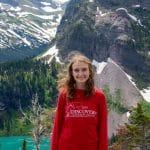
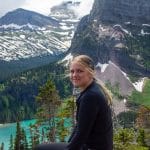
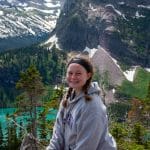
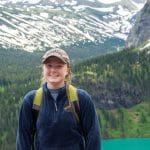
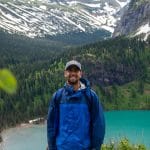
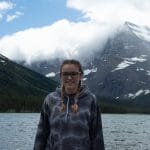
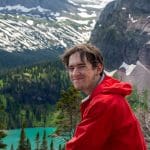
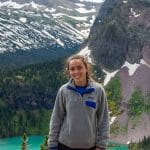
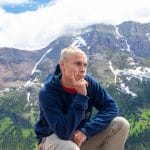
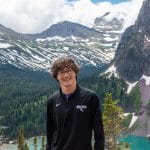
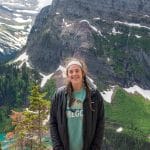
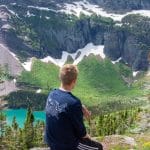
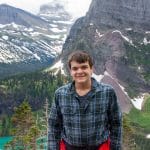
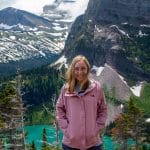
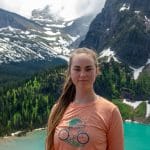

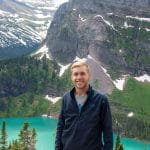
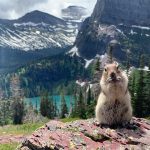
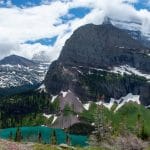
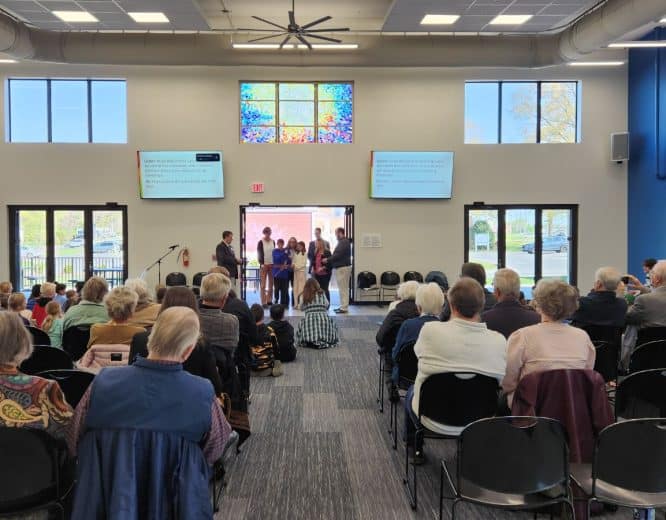
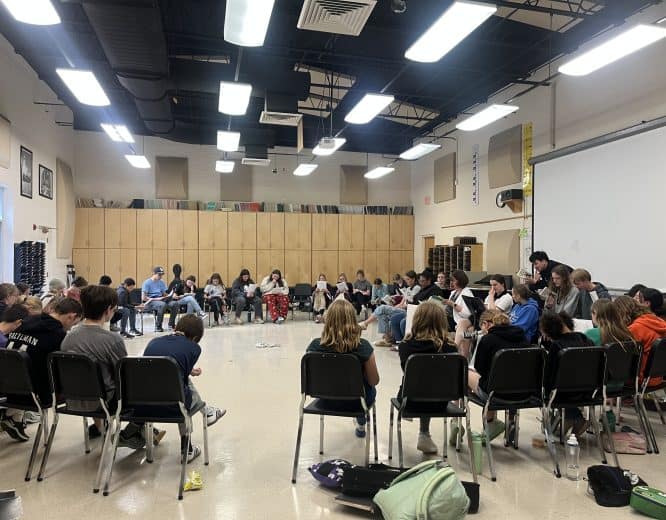
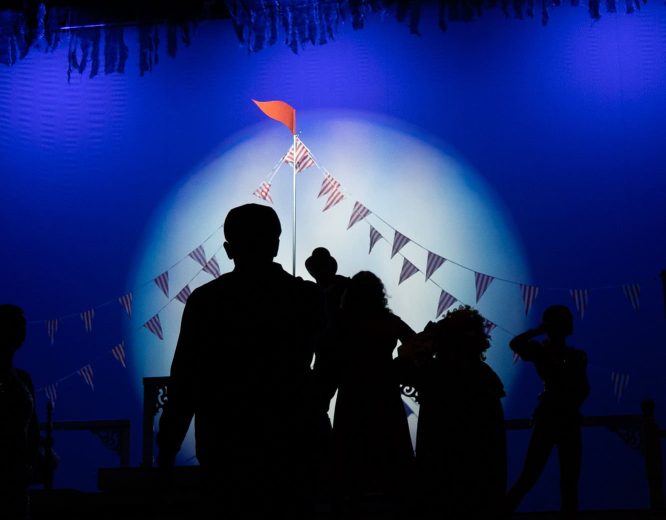
Un escrito tan maravilloso, que capturó mi imaginación, me hizo apreciar las maravillas de nuestro mundo, me impulsó a reflexionar y ser más consciente de mi propia huella de carbono y mi impacto en el mundo que me rodea. ¡Qué viaje tan maravilloso para estos millennials! Estoy absolutamente seguro de que estas aventuras seguirán teniendo un impacto duradero en sus vidas, como es evidente que ya lo ha tenido al leer varias de estas reflexiones, cartas y poemas escritos.
¡Es maravilloso saber de ti, Mónica, muchos meses después de que se publicó ese contenido! ¡Gracias por comunicarte y afirmar el programa!